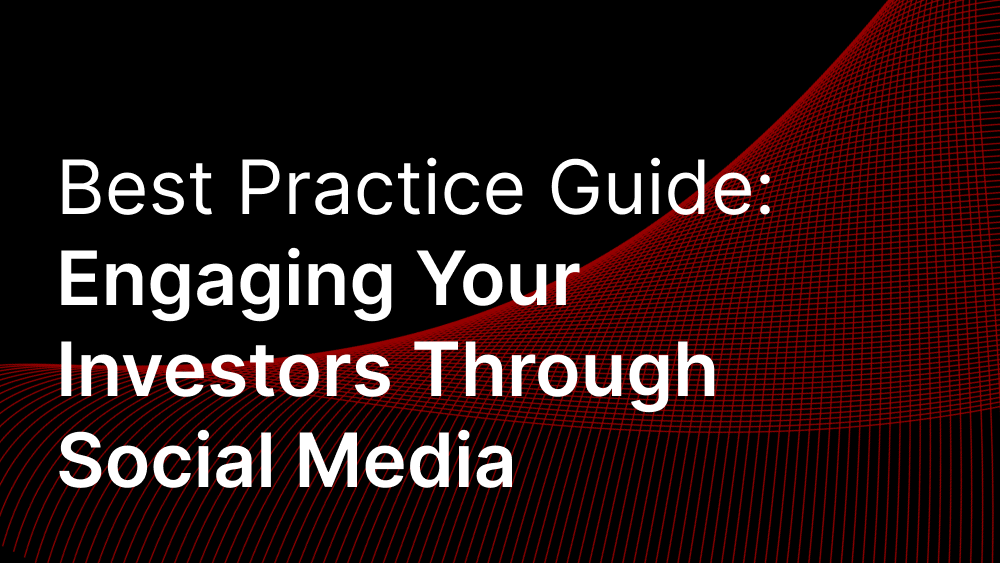Social media plays a critical role in creating a vivid online presence for financial services brands.
In our view social media has four important characteristics that make it indispensable in allowing firms to curate the kind of cultural presence increasingly regarded by allocators and investment consultants as table stakes.
1. It’s critical for presenting a rounded three dimensional brand experience.
2. It allows firms to continue engaging investors during a different phase of their user journey.
3. It provides a format where firms can showcase their story over time, giving a sense of direction and a narrative arc.
4. It also offers an opportunity for firms to better showcase their authenticity and communicate something of their corporate culture.
The data backs this up
The consensus is clear: in today’s digital age, it’s essential for firms to utilise social media for marketing and procurement so they don’t get left behind. In a 2019 study by Greenwich Associates, 63% of institutional investors said that they consume social media, whilst less than 50% consume finance-specific trade publications. And that’s not all. The study found that 68% of investors used social media to research asset management firms in 2018, up from 36% in 2015.
And if you thought that social media was just a tool for up-and-coming organisations, you’d be wrong. According to research by Putman Investments, the median age of a new client gained through social media has jumped from 35 to 40.
But how do you engage investors with social media and how do you know whether you’re doing it effectively? This best-practice guide highlights how to measure social media success, improve your content and ultimately grow your presence.
How do we measure social media effectiveness?

At Peregrine, we’ve developed our own diagnostics tool that evaluates how effectively your social media is performing, finding four key factors in measuring effectiveness:
1. Measure content consistency
How regularly are you sharing content? Post too infrequently and you become irrelevant and non-existent, post too often and risk becoming an annoyance and losing followers. Guidelines vary between platforms and industries and you need to find the sweet spot that will engage your network.
2. Optimise the content
Content is paramount in effectively engaging your following and it’s always important to consider the value you are delivering with the content you share. What story are you trying to tell and what kind of content will deliver this most effectively?
3. Review social media activity
Simply, how active are you on social media? How many platforms are you on and how effectively do you tailor your content to suit those platforms? Successful social media management spans across multiple platforms and provides bespoke content for each, in order to get the most out of your channels.
4. Measure social media Engagement
It’s all very well being present across multiple channels, but if your content fails to engage then unfortunately, your content is unlikely to have much impact. A crucial part of our methodology compares asset managers’ levels of social media engagement with average levels across the industry to show which firms excel and which have room for improvement.
Developing social media consistency

Writing Tweets is easy but the challenge lies in organising your content and getting it approved quickly. The time-sensitive nature of social media means that a delay of just one day can mean your content is no longer relevant. It’s really important that your organisation has a social media champion, supported by a solid digital process infrastructure.
There are tools out there that can help you achieve this. Tools like Monday.com help you plan content in one place that is visible to the wider team. Others like Hubspot or Hootsuite allow you to schedule posts in advance. These solutions can also be extremely helpful in providing analytics so you can track your performance.
Social media is all about current events, so keep an eye out for key calendar dates such as Pride or Independence Day and other news opportunities to share content and perspectives in real time. But remember to say something meaningful. Your followers will recognise humblebragging, and no one will take kindly to companies piggybacking on significant events as a means to promote their services.
Improving your content
Visuals are the first thing audiences will be drawn to when scrolling through your social media feed. Therefore, it’s important to develop a style that’s in line with your company’s brand guidelines and to stick to it to ensure your image is consistent and stands out to investors. You also need to make sure that any visuals used are in line with the format specifications for each platform.
We recommend always sharing positive coverage your company receives on social media. This not only helps to tell your story, but is also a great opportunity to engage with journalists and media outlets by tagging them in posts.
Inspiration for content creation can come from multiple places, such as around key company events which showcase your team and culture. Promoting your team, for example through introducing a new team member on social media, is a great way to put a human face to your company and is highly beneficial for talent acquisition.
Video is another great tool for communication, bringing dynamism to your feed and enabling you to avoid long-winded written documents. You should try to make videos no longer than 3 minutes though, as social media engagement tends to drop off then.
Responding to what’s happening in society is essential. We’re living in a time of generational events that are changing the social media landscape – does your company have something meaningful to add to the conversation?
Always include a clear call to action in your posts, whether it’s to download your content, sign up for an event or read more on your website. Your audience needs a directive, otherwise they’ll scroll past your content without taking longer-lasting action. Relevant thought-leadership will help drive followers to your website where you can see conversions.
Content can come in many forms and it’s up to you to find which one is most popular amongst your audience. Analysis of social media engagement on historical posts can help inform future strategy by allowing you to pinpoint what works and what doesn’t work.
Growing your presence

Presence is all about building a significant following and nurturing your channels so that they continue to grow. Much like growing seeds into saplings, it’s easy to achieve that initial growth spurt, but to keep your channels growing it requires a certain level of skill and dedication.
Running digital advertising campaigns and cross promoting on multiple platforms are a great way to ensure that your content is seen and casts a wider net for visibility with new followers.
Don’t undervalue the importance of a strong employee following. 84% of people trust recommendations made from friends/colleagues over other forms of marketing so your team are a great resource. Engage with your employees and they will act as advocates for your brand. It’s estimated that employee accounts have five times more reach than corporate accounts, so they can have a significant impact on the number of impressions when they share company content.
Finally, always remember to engage in organic community building through writing comments and reacting to relevant and interesting third party content. Not only does this provide another level of exposure for your brand but it’s also an opportunity to humanise your organisation.
When to use social media
Like any marketing tool, social media is not appropriate in every instance and it’s important to recognise what social media is good at and what it is bad at in order to optimise your channels. It is a great way for firms to capture feedback by communicating directly with their audience but it’s not a good place for lengthy expositions on complex financial matters that require a great deal of consideration from the audience. It’s also important to consider what’s appropriate for each platform. For example, Instagram is not the place to push financial products but is a great place to showcase your team’s spirit and company culture.
Exercise caution

As with everything, there are elements of compliance that you should make an effort to adhere to on social media. It’s a tricky subject and it’s made even trickier by the evolution of platforms, multiple guidelines and the fast pace of social media. It’s also worth noting that in the eyes of regulators, social media is not a real-time promotion so is subject to the same compliance requirements as webpages or printed ads.
Top tips to ensure compliance
1. Compliance should be everyone’s job and the more that senior members of the team can help, the smoother the sign-off will be. Having a designated person to sign off content will also help to speed up the process.
2. Content that focusses on generating social media engagement over advertising products puts you in a safer space.
3. Be careful with hashtags. Hashtags act like links to other pages where you don’t have control over the content so it may be irrelevant. The FCA recommends you don’t use hashtags altogether but if you’re going to use them, we suggest exercising cation.
4. It’s often a positive sign to see your audience taking the time to comment on your posts but if you’re concerned, don’t forget you can delete comments and turn them off completely if you choose.
5. In the USA, businesses are required by FINRA, SEC, FTC, FFIEC and ABA to maintain all posts for three years for audit purposes. Luckily, tools like Hootsuite can do that for you.
Social media is one of the most powerful tools in Integrated Marketing Communications (IMC). Used effectively, it can provide real authenticity to your brand and provide a human touch through showcasing your company’s culture. But in order for it to do that, it’s important to measure its effectiveness, maximising the quality of content you are putting out and focusing on growing your presence over time.


